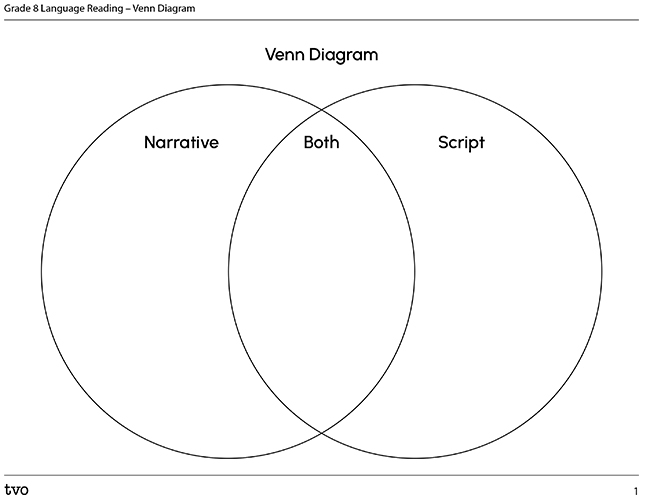Minds On
Script or narrative?
Student Success
Think-Pair-Share
Consider the following questions:
- What are some similarities and differences between a script and a narrative?
- What are some elements of a script and elements of a narrative that need to be considered?
Use the following Venn Diagram to organize your ideas. You can also complete this activity in your notebook or using the method of your choice.
Note to teachers: See your teacher guide for collaboration tools, ideas and suggestions.
Action
Characteristics of a script
A play script is a form of literature with unique text features. Explore the following example of a play script that was created for the purpose of demonstration. What text features do you notice?
Act 1 Opening – Part 1 (Joseph, Mira, Sameen)
(Joseph and Mira are stage left–LIGHT on children. Children are wearing long, wool coats, hats and mittens and are sitting on an old log by a dirt road)
Sameen enters the scene stage right – LIGHT on SAMEEN. SAMEEN is wearing a bonnet, a dress, leather boots and an overcoat
Joseph: Sameen? What are you doing here? (JOSEPH rises and walks quickly DOWN STAGE toward SAMEEN, looking around him as he does)
Sameen: (smiling she kneels down to pick up the bag she just dropped) I just arrived!
Mira: (Whispering) We are so happy to see you! (stands and runs DOWN STAGE)
Joseph: (frowning while staring at SAMEEN’s bag) You said that you would not return for weeks!
Mira: (hands on her hips while watching SAMEEN hide her bag behind her back) Joseph! Why are you always so quick to reprimand Sameen? This is not her fault!
Sameen: (sheepishly) I was just so happy they let me return.
Joseph: (shaking his head, walking slowly OFF STAGE, angrily) I don’t believe that at all!
Brainstorm
Share your thoughts
How are the text features similar to text features in other text forms? How are they different? How do the text features help you as a reader?
Record your ideas using a method of your choice.
Reading a script: character
Reading a script is a unique experience! Unlike a narrative text, the characters in a play are not described in great detail. This means that readers have to use the text features in a script to make inferences (e.g., dialogue, scene descriptions, and stage directions). In essence, the combination of different text features help the reader develop their understanding of the characters.

Reading a script: setting
Where does the play take place? Similar to a narrative, a play also has at least one location or setting. Each scene has a description of the setting, which often includes the time of day.

Reading a script: the stage direction
Every play script has stage directions. These appear in the middle of parentheses () and guide how the actors move and behave on stage.
For example:
Joseph: (frowning while staring at SAMEEN’s bag) You said that you would not return for weeks!
In this line, the stage directions tell the actor to frown and stare at a prop as they speak their line. This piece of information helps the actor shape their performance and communicate their emotions to the audience.

What do you think?
Return to the script excerpt at the start of the Action section. What can you learn about the characters and the setting through the different text features?
Record your ideas using a method of a your choice.
Consolidation
Analyzing a script
Use the following questions to analyze one of the following script excerpts.
- Describe the text features you notice. How are they similar to the text features in a narrative text? How are they different?
- What information does this excerpt provide you with about the characters, setting, and plot?
- What information do the stage directions provide you with about the story?
- Would you seek out more books that have been adapted into play scripts? Why or why not?
Record your responses using a method of your choice.

Script one
Act 1 Opening — Part 1 — Hallway of an elementary school in Ontario
(STUDENTS are walking up the stairwell into the Intermediate hallway and heading to their lockers. Everyone is wearing their coats and boots. Snow is puddling under their feet as they remove their boots for their indoor shoes. Two students are walking slower, behind the others, having a quiet but excited conversation as they round the corner of the hallway.)
STUDENT 1: (removing their backpack quickly, opening the zipper and reaching into the pocket to pull out a paper) I stayed up so late last night to write this! (slowly reaches paper toward friend)
STUDENT 2: (a wide smile on their face) LET ME SEE!
STUDENT 1: (sheepishly, eyes down) I hope it is ok. I know I wrote it for both of us.
STUDENT 2: (dropping backpack into locker while reading paper) Are you kidding? This is AMAZING!
STUDENT 1: (shoulders drop, immediately relieved. Sighs loudly) I am so happy to hear that. (voice rising and getting faster) I can’t believe we have to say this in front of the whole school today of all days! This might be one of the biggest events to happen here and we have to introduce them? I am soooooo nervous!
The two students walk into the classroom. The other students look up at them.
TEACHER: (quietly) OK, you two, You better head down now, You will do great!
Script two
The second script is from an abridged version (a shortened, adapted version) of William Shakespeare’s Romeo and Juliet, which is the story of two young adults from Verona, Italy, who fall in love.
(Later that night, after the party was over, Romeo left his friends, and sneaked back to Juliet’s house. There, he saw her on her balcony.)
Benvolio: (Whispering.) Romeo! My cousin Romeo! Where are you?
Mercutio: He is wise, and has gone home to bed.
Benvolio: He ran this way, and leaped this orchard wall. Call, good Mercutio.
Mercutio: Nay, I won’t. Romeo, good night. Come Benvolio, it is too cold for me here now.
(Exit Benvolio and Mercutio. Enter Romeo, seeing Juliet come out on her balcony.)
Romeo: But soft, what light through yonder window break? It is the east, and Juliet is the sun. It is my lady; O, it is my love.
Juliet: (Sighing.) Ay, me.
Romeo: She speaks! O, speak again!
Juliet: O, Romeo, Romeo, wherefore art thou, Romeo? Deny they father, and refuse your name. O, be some other name! What’s in a name? That which we call a rose, by any other name would smell as sweet.
Romeo: (Stepping out into the open.) I take thee at thy word.
Juliet: What man art thou, thus bescreened in night?
Romeo: I know not how to tell thee who I am.
Juliet: Art thou not Romeo? How cam’st thou hither?
Romeo: With love’s light wings did I o’er-perch these walls.
Reflection
As you read the following descriptions, select the one that best describes your current understanding of the learning in this activity. Press the corresponding button once you have made your choice.
I feel...
Now, expand on your ideas by recording your thoughts using a voice recorder, speech-to-text, or writing tool.
When you review your notes on this learning activity later, reflect on whether you would select a different description based on your further review of the material in this learning activity.
